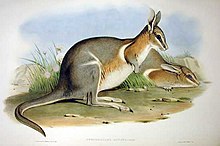Nail-tail wallaby
| Nail-tail wallabies | |
|---|---|

| |
| Crescent nail-tail wallaby | |
| Scientific classification | |
| Domain: | Eukaryota |
| Kingdom: | Animalia |
| Phylum: | Chordata |
| Class: | Mammalia |
| Infraclass: | Marsupialia |
| Order: | Diprotodontia |
| Family: | Macropodidae |
| Subfamily: | Macropodinae |
| Genus: | Onychogalea J. E. Gray, 1841 |
| Type species | |
| Macropus unguifer[1] Gould, 1841
| |
| Species | |
The nail-tail wallabies, of genus Onychogalea, are three species of macropods, all found in Australia. Related to kangaroos and wallabies, they are smaller species distinguished by a horny spur at the end of their tail. The northern nail-tail wallaby is still common in the northern part of Australia,[2] the crescent nail-tail is now extinct,[3] and the bridled nail-tail is considered rare and endangered, with probably fewer than 1100 mature individuals in the wild.[4] Nail-tail wallabies are smaller than many other wallabies.[5]
Taxonomy
[edit]There are three recognised species of the genus Onychogalea, the nail-tailed wallabies, they are:[1]
- Onychogalea fraenata, the bridled nailtail, whose range and population has greatly declined since colonisation;
- Onychogalea lunata, the crescent nailtail, warong, once abundant and widespread across the southwest and centre, the smallest species entered a rapid decline and became extinct;
- Onychogalea unguifera the northern species, still extant in the Kimberley and Top End regions.
Description
[edit]A genus of Macropodidae, small and herbivorous species with a shy disposition. The earliest descriptions noted their elegant shape, graceful movements and beautiful markings.[6] Named for one of their general characteristics, the nail-tailed wallaby has a horny point two or three millimetres wide at the tip of the tail, an almost unknown characteristic for a mammal that has been compared to the bony spur of a lion's tail.[7][6]
References
[edit]- ^ a b Groves, C. P. (2005). Wilson, D. E.; Reeder, D. M. (eds.). Mammal Species of the World: A Taxonomic and Geographic Reference (3rd ed.). Baltimore: Johns Hopkins University Press. p. 63. ISBN 0-801-88221-4. OCLC 62265494.
- ^ International Union for Conservation of Nature and Natural Resources "Onychogalea unguifera", The IUCN Red List of Threatened Species, 2008
- ^ International Union for Conservation of Nature and Natural Resources "Onychogalea lunata", The IUCN Red List of Threatened Species, 2008
- ^ International Union for Conservation of Nature and Natural Resources "Onychogalea fraenata", The IUCN Red List of Threatened Species, 2008
- ^ Menkhorst, Peter (2001). A Field Guide to the Mammals of Australia. Oxford University Press. p. 124.
- ^ a b Gould, J. (1863). "Introduction". The mammals of Australia. Vol. 1. p. xxi.
- ^ Thomas, O. (1888). Catalogue of the Marsupialia and Monotremata in the collection of the British Museum (Natural History). London. p. 77.
{{cite book}}: CS1 maint: location missing publisher (link)
External links
[edit]- "Onychogalea Gray, 1841". Atlas of Living Australia.
 Media related to Onychogalea at Wikimedia Commons
Media related to Onychogalea at Wikimedia Commons
